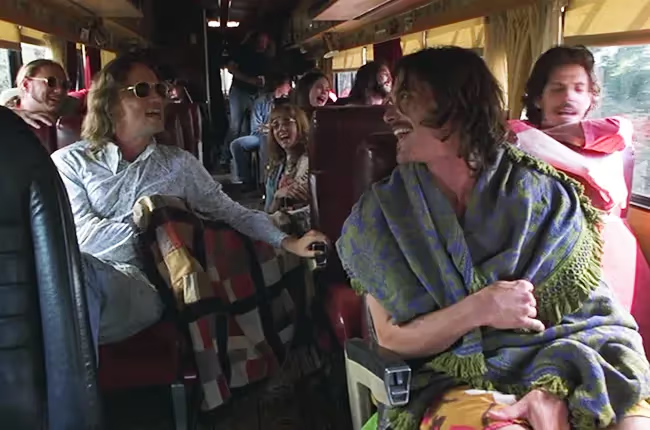Anatomy of a Singalong: “Tiny Dancer” and the Bittersweet Soul of ‘Almost Famous’
For his 2000 film, Cameron Crowe used a semi-forgotten Elton John to create an unforgettable scene.

“I always wanted to feel that I was able to earn the song,” Cameron Crowe says in a 2013 interview recorded for Elton John’s YouTube page. The song he’s referring to is “Tiny Dancer,” which soundtracks a scene in Crowe’s 2000 film Almost Famous that Crowe calls “the soul of the movie.” Anyone who’s seen Almost Famous understands what he means. It’s the film’s best-known sequence, a singalong lasting just over two minutes that does little to advance the plot but reveals much about the film’s characters, their relationships to one another, and the makeshift family they’ve become.
Yet as joyous and celebratory as it appears on the surface, dark undercurrents course through the moment, just as they do through the rest of the movie. The music is soaring and the unity it creates is genuine, but so is the sense that the togetherness might not last and the bus’s passengers will resume the already-in-progress process of falling apart. Warm and fragile, it depicts a fleeting instant of pleasure that’s willfully blind to what happens next and any consequences that focussing on the present might create. Crowe is right to call it the movie’s soul.
Why does it work so well? It starts with the song. “Tiny Dancer” is the first track on John’s 1971 album Madman Across the Water. That makes it a product of a period in John’s career when he and songwriting partner Bernie Taupin began releasing music at a rapid-fire clip with escalating commercial and critical success. But though John had made appearances on the singles chart, Madman preceded the period when seemingly every song he released would become inescapable, a phase that would begin in earnest with 1972’s Honky Château, which yielded both “Honkey Cat” and “Rocket Man.” “Tiny Dancer” failed even to crack the Billboard Top 40, stalling out at the #41 spot. When John released his first greatest hits album in 1975, it was nowhere to be found. That didn’t make “Tiny Dancer” an obscurity. Madman Across the Water sold well over the years, radio stations returned to it as John’s fame grew, and John frequently performed the song live. But in 2000, it wasn’t among John’s best-known songs, which made it more useful to Crowe than one freighted with years of other associations. It’s hard to imagine an alternate version with “Your Song” or “Goodbye Yellow Brick Road” working as well, or working at all.
“Tiny Dancer” had been used in a previous film, however. A minor hit in 1975, Floyd Mutrux’s Aloha, Bobby and Rose depicts a doomed love story between Bobby (Paul LeMat), an L.A. mechanic/hot rod enthusiast trying to outrun a debt owed to some violent pool sharks, and Rose (Dianne Hull), a waitress and single mother. The story largely unfolds over a weekend in which the local station has chosen to spotlight Elton John’s music, allowing John’s songs to provide a dramatic counterpoint to the action. (It seems possible Quentin Tarantino filed this detail away and dropped a
This post is for paying members only
Sign up now to read the post and get access to the full library of posts for subscribers only.
✦ Sign up